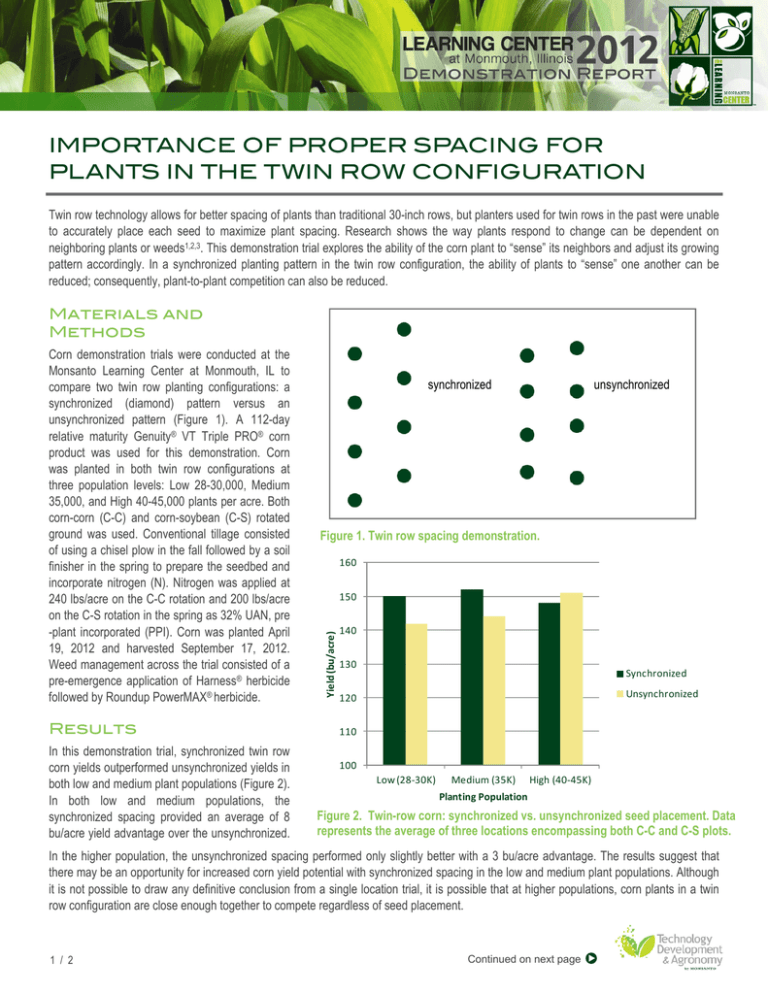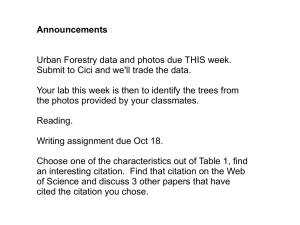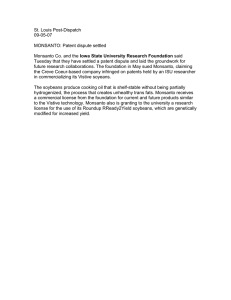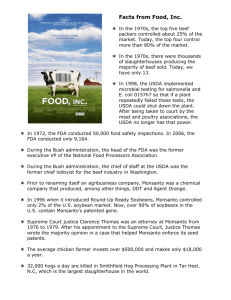importance of proper spacing for plants in the twin row
advertisement

IMPORTANCE OF PROPER SPACING FOR PLANTS IN THE TWIN ROW CONFIGURATION Twin row technology allows for better spacing of plants than traditional 30-inch rows, but planters used for twin rows in the past were unable to accurately place each seed to maximize plant spacing. Research shows the way plants respond to change can be dependent on neighboring plants or weeds1,2,3. This demonstration trial explores the ability of the corn plant to “sense” its neighbors and adjust its growing pattern accordingly. In a synchronized planting pattern in the twin row configuration, the ability of plants to “sense” one another can be reduced; consequently, plant-to-plant competition can also be reduced. Materials and Methods Results In this demonstration trial, synchronized twin row corn yields outperformed unsynchronized yields in both low and medium plant populations (Figure 2). In both low and medium populations, the synchronized spacing provided an average of 8 bu/acre yield advantage over the unsynchronized. synchronized unsynchronized Figure 1. Twin row spacing demonstration. 160 150 Yield (bu/acre) Corn demonstration trials were conducted at the Monsanto Learning Center at Monmouth, IL to compare two twin row planting configurations: a synchronized (diamond) pattern versus an unsynchronized pattern (Figure 1). A 112-day relative maturity Genuity® VT Triple PRO® corn product was used for this demonstration. Corn was planted in both twin row configurations at three population levels: Low 28-30,000, Medium 35,000, and High 40-45,000 plants per acre. Both corn-corn (C-C) and corn-soybean (C-S) rotated ground was used. Conventional tillage consisted of using a chisel plow in the fall followed by a soil finisher in the spring to prepare the seedbed and incorporate nitrogen (N). Nitrogen was applied at 240 lbs/acre on the C-C rotation and 200 lbs/acre on the C-S rotation in the spring as 32% UAN, pre -plant incorporated (PPI). Corn was planted April 19, 2012 and harvested September 17, 2012. Weed management across the trial consisted of a pre-emergence application of Harness® herbicide followed by Roundup PowerMAX® herbicide. 140 130 Synchronized Unsynchronized 120 110 100 Low (28‐30K) Medium (35K) High (40‐45K) Planting Population Figure 2. Twin-row corn: synchronized vs. unsynchronized seed placement. Data represents the average of three locations encompassing both C-C and C-S plots. In the higher population, the unsynchronized spacing performed only slightly better with a 3 bu/acre advantage. The results suggest that there may be an opportunity for increased corn yield potential with synchronized spacing in the low and medium plant populations. Although it is not possible to draw any definitive conclusion from a single location trial, it is possible that at higher populations, corn plants in a twin row configuration are close enough together to compete regardless of seed placement. 1 / 2 Continued on next page IMPORTANCE OF PROPER SPACING FOR PLANTS IN THE TWIN ROW CONFIGURATION from previous page Summary Comments Narrower rows are thought to be the solution for managing higher plant densities, but poor weather conditions can mask any potential benefits that you would expect to find in a more favorable growing environment. The primary benefit of narrow row configurations is to increase yield potential by increasing plant density per acre while also increasing plant-to-plant spacing. Drought conditions across most of the corn belt in 2012 were more likely to cause negative effects in high plant densities compared with low plant densities due to the added stress of interplant competition. Therefore, maximizing the space between plants may be most important at lower-to-normal planting populations due to the inability of neighboring plants to compete with one another in adverse environments. There are other factors that can be influential as well such as hybrid, soil type and soil depth. The Monsanto Learning Center at Monmouth, IL will continue to evaluate synchronized versus unsynchronized twin row configurations in order to evaluate the experiment under different growing conditions. The information discussed in this report is from a single site, non-replicated, one-year demonstration. Figure 3. Synchronized pattern at 35,000 plants per acre. This informational piece is designed to report the results of this demonstration and is not intended to infer any confirmed trends. Please use this information accordingly. References 1Aphalo, P. et al. 1999. Plant-plant signaling, the shade-avoidance response and competition. Journal of Experimental Botany vol 50:1629-1634. 2Kasperbauer, M. and D. Karlen. 1994. Plant spacing and reflected far-red light effects on phytochrome-regulated photosynthate allocation in corn seedlings. Crop Science vol 34:1564-1569. 3Rajcan, I. et. al. 2004. Red-far-red ratio of reflected light: a hypothesis of why early-season weed control is important in corn. Weed Science vol 52:774-778. Monsanto Company is a member of Excellence Through Stewardship® (ETS). Monsanto products are commercialized in accordance with ETS Product Launch Stewardship Guidance, and in compliance with Monsanto’s Policy for Commercialization of Biotechnology-Derived Plant Products in Commodity Crops. This product has been approved for import into key export markets with functioning regulatory systems. Any crop or material produced from this product can only be exported to, or used, processed or sold in countries where all necessary regulatory approvals have been granted. It is a violation of national and international law to move material containing biotech traits across boundaries into nations where import is not permitted. Growers should talk to their grain handler or product purchaser to confirm their buying position for this product. Excellence Through Stewardship® is a registered trademark of Biotechnology Industry Organization. B.t. products may not yet be registered in all states. Check with your Monsanto representative for the registration status in your state. Roundup Technology® includes Monsanto's glyphosate-based herbicide technologies. Individual results may vary, and performance may vary from location to location and from year to year. This result may not be an indicator of results you may obtain as local growing, soil and weather conditions may vary. Growers should evaluate data from multiple locations and years whenever possible. ALWAYS READ AND FOLLOW PESTICIDE LABEL DIRECTIONS. Roundup Ready® crops contain genes that confer tolerance to glyphosate, the active ingredient in Roundup® brand agricultural herbicides. Roundup® brand agricultural herbicides will kill crops that are not tolerant to glyphosate. Harness® is not registered in all states. Harness® may be subject to use restrictions in some states. The distribution, sale, or use of an unregistered pesticide is a violation of federal and/or state law and is strictly prohibited. Check with your local Monsanto dealer or representative for the product registration status in your state. Genuity®, Harness®, Roundup PowerMAX®, Roundup Ready 2 Technology and Design®, Roundup Ready®, Roundup Technology®, Roundup® and VT Triple PRO® are registered trademarks of Monsanto Technology LLC. Leaf Design℠ is a servicemark of Monsanto Company. Respect the Refuge and Corn Design® and Respect the Refuge® are registered trademarks of National Corn Growers Association. ©2012 Monsanto Company. 11132012JMG. 2 / 2



